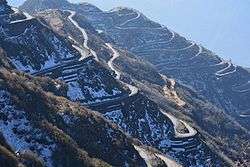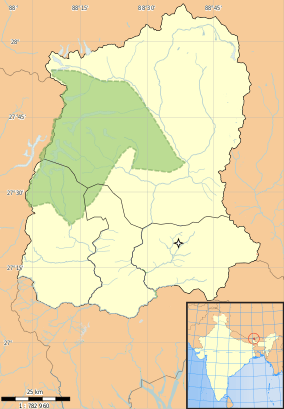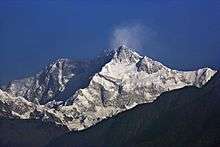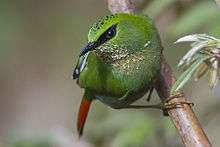Dzuluk
| Dzuluk | |
|---|---|
| Hamlet | |
 The switchback road at Dzuluk | |
 Dzuluk  Dzuluk | |
| Coordinates: 27°15′04″N 88°46′30″E / 27.2509908°N 88.7750191°ECoordinates: 27°15′04″N 88°46′30″E / 27.2509908°N 88.7750191°E | |
| Elevation | 3,000 m (10,000 ft) |
| Population | |
| • Total | 700 |
Dzuluk or Zuluk or Jhuluk or Jaluk is a small hamlet located at a height of around 10,000 feet (3,000 m) on the rugged terrain of the lower Himalayas in East Sikkim of the Indian state Sikkim (Pincode 737131). This place is relatively an emerging and offbeat destination in East Sikkim. Today it is fast emerging as a new tourist destination. It derives its tourism importance due to the excellent view of the eastern Himalayan mountain range including the Kanchenjunga.[1]
Historical importance
It was once a transit point to the historic Silk Route[2] from Tibet to India. The famous silk route that connected Lhasa[3] (Tibet) to Kalimpong was in use even a few decades ago until the Chinese invasion of Tibet. It was commonly used by traders traveling to Tibet through Jelep-la ("La" stands for mountain pass) as an overnight base. The route started from Kalimpong and passed through Pedong, Aritar, Dzuluk and Jelepla to Chumbi valley in Tibet.

Geography
Dzuluk is located at 27°15′06″N 88°46′39″E / 27.2518°N 88.7775°E.
Climate
Dzuluk at an altitude of about 10,000 ft offers pleasant weather during most of the year. The summer temperature would be near 20 °C (68 °F) with substantial difference between the day and night temperature. The rainy season is a little protracted and heavy to very heavy showers are common. The winter may see snowfall in the area of about 3–5 feet (0.91–1.52 m) of snow.
- October to February — winter, cold and snow.
- March to May —Pleasant cold.
- June to September — the monsoon season, Cold and Beautiful.
Flora and fauna
Dzuluk is surrounded by wild forest, some of the forests are completely virgin. Sighting of Deer, Wild Dog, Himalayan Bear the red panda is not very uncommon. Some tigers have also reportedly been sighted in the area.

A variety of birds can also be seen such as Blood Pheasant, Himalayan monal, Kalij pheasant, Snow Pheasant and others.During the summer months, the area and its surrounding hills are covered with thousands of blooming rhododendron. Dzuluk during these months, is a riot of colors due to the variety of rhododendron that can be seen here.
Population
This small village accommodates a population of around 700 people. They are largely immigrants from Nepal who came and settled here in the hope of a better future. There is an Indian Army base at Dzuluk, which has been used as a transit camp for the army movement to the Indo-Chinese border nearby. Due to poor quality of the soil and vagaries of weather, farming is well nigh impossible. Neither is there any possibility for cattle rearing as an occupation; most of the land is fenced and military-controlled, making it unfit for grazing. Construction and road maintenance are the only livelihoods.
Transport
- Air
The Bagdogra Airport,[4] (IATA airport code IXB) in Siliguri, West Bengal is the nearest airport. One can drive for around 7–8 hours from there to reach Dzuluk.
- Train
New Jalpaiguri railway Station (NJP) in West Bengal is the closest railway station. A drive of around 7–8 hours will take one to Dzuluk.
- Road
Dzuluk can be reached from Siliguri by various hired vehicle in roughly 7 hours. Tourists can also travel to Dzuluk from Gangtok in roughly 4 hours by hiring vehicles.
Nearby places
The three-level switchback roads of Dzuluk offer views of the Kanchenjunga and its mountain range. The other attractions of the place include lakes, temples, route that leads to Tibet. Some of the forests situated around Dzuluk are completely unexplored and offer a variety of flora and fauna.

Points of interest include:
- Thambi View Point
- Lungthung
- Tukla
- Nathang Valley
- Old Baba Mandir
- Kupup
- Memenchu Lake
- Zig Zag Point
- Young Husband's Track
- Aritar Lake
References
- ↑ Freshfield, D. W. (1903). Round Kangchenjunga: a narrative of mountain travel and exploration. London: Edward Arnold.
- ↑ Xinru Liu. The Silk Road In World History (PDF). Oxford University Press.
- ↑ Anne-Marie Blondeau and Yonten Gyatso, 'Lhasa, Legend and History,'in Françoise Pommaret-Imaeda (ed.)Lhasa in the seventeenth century: the capital of the Dalai Lamas, BRILL, 2003, pp.15–38, pp.21–22.
- ↑